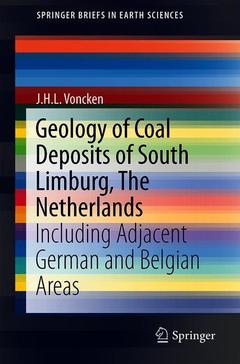Geology of Coal Deposits of South Limburg, The Netherlands, 1st ed. 2020 Including Adjacent German and Belgian Areas SpringerBriefs in Earth Sciences Series
Auteur : Voncken J.H.L.

This book offers an up-to-date overview of the coal deposits of South Limburg (Netherlands), the Aachen area (Germany), and the Campine area (Belgium). Although the amount of available literature on these coal deposits is quite vast, the majority of the texts date back to the mid-twentieth century, and most publications focus more on the stratigraphy of the coal layers and the rank of the coal. Moreover, the concept of continental drift is largely ignored in these publications.
In addition to providing updated information, this book also discusses coal mining in these regions; the formation and petrography of coal; and the geological evolution of Western Europe/the Netherlands, Germany and Belgium. In order to explain the tropical nature of the flora in the Carboniferous period, paleogeographic aspects are also taken into account.
Jack Voncken (1959) studied Geology at Utrecht University, the Netherlands. In 1984 he passed his “Doctoraal Examen” (equivalent to an M.Sc.) in Geology with a major in (Igneous) Petrology and minors in Exploration Geochemistry and Economic Geology. After graduating he pursued Ph.D. research, also at Utrecht University, on the synthesis, characterization and crystallography of two rare ammonium-aluminum silicates (buddingtonite, NH4AlSi3O8, and tobelite, NH4Al2Si3AlO10(OH)2) and their Rb and Cs analogues. He obtained his Ph.D. from Utrecht University with a thesis entitled “Silicates with Incorporation of NH4+, Rb+ or Cs+”.
From 1988 to 1990, he was employed at the Faculty of Chemical Technology, Twente University of Technology, Enschede, the Netherlands, where he developed a method for measuring drying stresses in thin drying gel coatings. In 1990 he joined Delft University of Technology. He started at the Faculty of Mining and Petroleum Engineering, in the Raw Materials Technology (later called Resource Engineering) section, as an Assistant Professor for Mineralogical Aspects of Raw Materials. From 2006 to 2011, after the discontinuation of the Resource Engineering section, he worked in the Applied Geology section. After the re-establishment of the Resource Engineering section in 2011, he returned to that group, again as an Assistant Professor. The Faculty of Mining and Petroleum Engineering merged with the Faculty of Civil Engineering in 2007 to form the Faculty of Civil Engineering and Geosciences. Jack Voncken’s specialties lie in Economic Geology, in Ore Minerals and Industrial Minerals, and in analytical and characterization techniques for minerals and rocks. Given his interest in Ores and Industrial Minerals, he has also focused on Rare Earth Elements since 2009.
Date de parution : 05-2019
Ouvrage de 78 p.
15.5x23.5 cm
